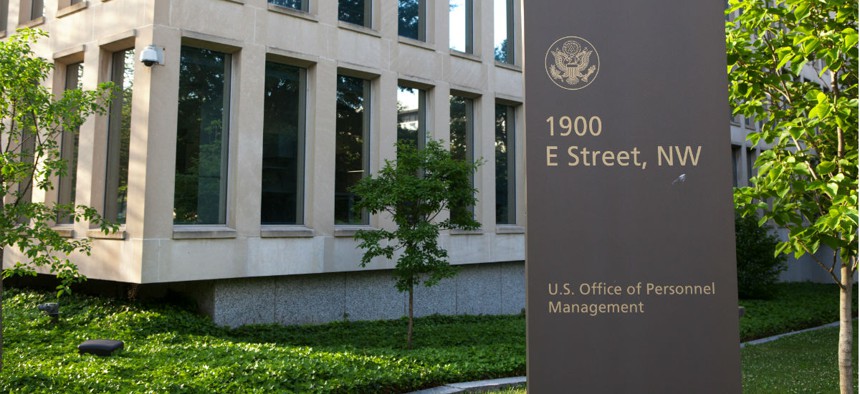
Mark Van Scyoc / Shutterstock.com
Despite Leadership Shake-Up, Transfer of OPM Services to GSA Remains in Doubt
Legal questions and a lack of “vision” for shifting many services threaten to prevent the renewed reorganization effort from becoming reality.
Although a leadership shake-up at the Office of Personnel Management reinvigorated talk of transferring the agency's health benefits, retirement and other services to the General Services Administration, questions remain about the legality of the proposal and whether it will actually improve outcomes.
Earlier this month, then-OPM Director Jeff Pon was asked to resign, and he was swiftly replaced temporarily by Office of Management and Budget Deputy Director for Management Margaret Weichert. At the heart of the shake-up was Pon’s resistance to the proposed reorganization of OPM, an initiative Weichert said she will pursue vigorously.
But a source familiar with the administration’s deliberations on the subject said that although the Trump administration does intend to push forward with the plan, it is unclear how much is possible without congressional approval.
“From what I understand, there’s still work underway to get legal clarity on whether this requires Congress or not,” the source said. “That may influence and dictate how much or [whether] all of these changes will occur. But with that, there’s this legal question kind of hanging over things, and as a result, I think folks are going through the motions of doing the work, but also waiting on guidance and direction from the White House in terms of next steps.”
A recently released report from the Congressional Research Service suggested that several aspects of the OPM reorganization plan would indeed require statutory changes to the 1978 Civil Service Reform Act, which established the government human resources agency. The report concluded that moving transactional services to GSA would require statutory changes for funding purposes, and that moving Retirement Services to GSA and OPM's policy arm to the White House both would require legislation amending the Civil Service Reform Act.
Federal employee and retiree groups also noted the potential legal hurdles.
“This isn’t just the restructuring of an agency—it’s moving it elsewhere, entirely,” said Jessica Klement, staff vice president for advocacy at the National Active and Retired Federal Employees Association. “We’re asking Congress to take a good look at this, because we think it would require legislation.”
President Trump’s reorganization plan calls for most of OPM’s core functions to go to GSA, including the Federal Employees Health Benefits Program, retirement services and HR Solutions, while security clearance background investigations would be sent to the Pentagon. The agency’s policy shop would be sent to the Executive Office of the President. Klement said installing an OMB official as acting director of OPM is the logical step to implement that last proposal on an interim basis.
“I think it’s very clear where OPM policy will go from here,” she said.
A spokesperson for Weichert at OMB directed inquiries about the reorganization to OPM. OPM did not respond to a request for comment.
Another aspect of the plan that could impede its enactment is a lack of specificity. The reorganization proposal suggests that “the placement of other OPM offices and functions will be determined at a later date.” The Congressional Research Service found that fully 16 agency functions, including upholding merit system principles, are not yet accounted for in the reorganization plan. The source familiar with the administration’s thinking said this could prove to be a significant hang-up.
“It’s always good to look at things and try to do better, but having a full plan is important,” the source said. “In industry especially, agile approaches are very in vogue, but I’m not confident a board of directors would approve a merger and acquisition without knowing what the desired end state would be, and that’s the situation we have right now. There’s this vaguely defined end state, without a clear articulation of the pros and cons.”
The source said that from a policy perspective, there likely are ways that GSA could improve some of OPM’s service delivery, particularly with fee-for-service activities like HR Solutions.
“There are some obvious efficiencies that make sense, insofar as GSA is already doing central transactional processing for a lot of the government on other things,” the source said. “I think many folks have felt over the years that the fee-for-service activities distracted, or may have even driven some policy decisions or considerations at OPM in a way that wasn’t ideal . . . They do have walls in place [between these programs], but perception matters.”
But there are unanswered questions about how GSA could improve on functions that OPM already does well, particularly administration of FEHBP. Last month, the agency announced that the health insurance program would post the lowest premium increase in more than two decades in 2019.
“There’s definitely a potential [to lose ground in strong programs],” the source said. “Do we lose employees in the process [of transition to GSA], does talent leave that’s been critical to the success of these programs? And how does someone maintain focus on this when the GSA administration has a lot of other issues on their plate?”
They noted that administering an insurance program is dissimilar to GSA’s other procurement duties. There are more than 250 national and regional plans for 8 million participants in FEHBP, and insurance is far more actuarial than other contracting industries. Klement, too, questioned the benefit of sending OPM’s successful programs under a new roof.
“It’s hard to say what would happen without any info,” she said. “You could assume that you take all the same people doing the same jobs, and move them from OPM to GSA, but does anything really change? . . . Retirement services is a bit of a different beast, as they’ve had a number of problems over the years, but if you move to GSA, will they not have the cave [housing paper retirement records] in Boyers, [Pa.]?”
NEXT STORY: Improving Employee Engagement







